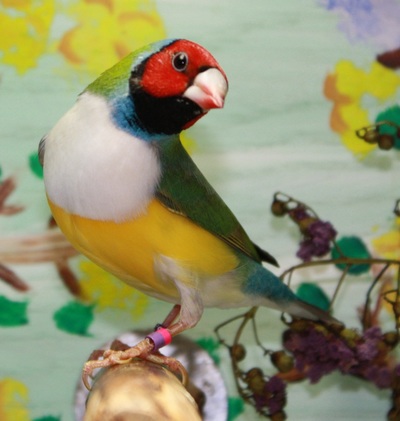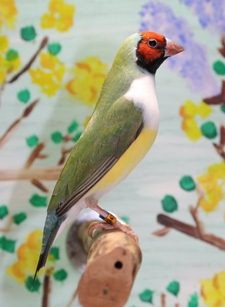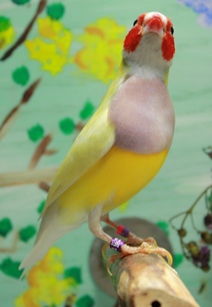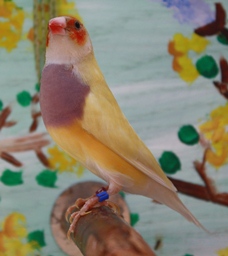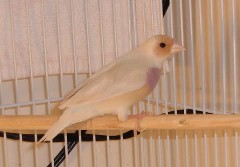Body Color GeneticsIn terms of possible colors, gouldian hens come in four different visual body colors: Green, Yellow, Blue and Silver.
Gouldian cocks come in six different visual body colors: Green, Dilute Green, Yellow, Blue, Pastel Blue and Silver. Briefly, the reason cocks come in more colors is due to the sex-linked Pastel gene. This will be explained more later. At the end of the body color explanations you can see charts of some of the possible combinations that can be produced based on the body colors of the parents. |
Certain body colors affect the expression of other pigments. I.e., the yellow body color gene prevents the expression of black pigment, while the presence of two recessive blue genes inhibits the expression of red and orange coloration. A link to a separate section describing pigmentation and how the genes affect it is found at the end of this page.
Normal/Green Body
Green body can be considered the "wild type", and is also referred to as "normal body." The green body color is due to a combination of genes, pigments, and structural colors which result in the green color we see. Often, you will see green body described as "sex-linked dominant" which is probably in an effort to avoid confusion, though it is not entirely accurate. The genes, et.al., responsible for the green body coloration are incompletely dominant to yellow body, and dominant to blue body.
SF Pastel Green (Dilute or SF Yellow Cocks & Yellow Hens)
The Pastel gene is sex-linked (located on the Z chromosome) and incompletely dominant to the genes responsible for the green wild type bird. You can think of Incomplete Dominance as the genes mixing cohesively together, with neither being dominant over the other, blending smoothly, like mixing red and white paint together to produce pink colored paint. It is a sex-linked gene, which means cocks can be “Single-Factor” – SF – or “Double-Factor” – DF – for this Pastel gene while hens can only be SF with complete expression. The Pastel gene works by interfering with black pigment present in the feather, called eumelanin, so any area which would normally be black on a green bird appears smoky gray or white/off-white. This is why genetically black headed birds fully expressing the Pastel gene appear to have white or near-white heads. The absence of eumelanin also prevents structural blue color, turning the bird yellow. Hens, by default (being ZY genetically) can only be SF - the presence of the Pastel gene will always result in the total inhibition of melanin producing a visually yellow bird. The full name for this is “SF Pastel Green Hen” – because the Pastel is taking place on a bird that is of Green body background.
Cocks that are SF Pastel Green with a Purple Breast are also called “Dilutes” in the US. This can be confusing, because there is a separate autosomal recessive mutation referred to as “Dilute” in other countries. PB SF Pastel Green cocks are a blend of Green+Yellow color, resulting in a shade that varies between Lemon-Lime to Lime-Green on the back.
If a cock is Lilac or White Breast and SF Pastel Green, they will appear visually yellow in color. This is not entirely understood but it may have something to do with the Lilac and/or White breast further interacting on feather melanins.
A lot of people ask me how to tell the difference between a SF Pastel Green and DF Pastel Green that is WB or LB. You can typically make an educated guess by checking the color of his bib. In a SF male this will appear grey in color, in a DF bird it will be very nearly white; because the two Pastel genes are completely blocking the expression of black pigment. Also, the turquoise band behind the mask of SF Pastel Greens tends to be much brighter/evident in SFs than on DFs.
The other question I encounter often relates to sexing WB and LB Pastel Green birds – the easiest way to do this is by looking at the beak. Mature males will have a “lipstick” kissed look at the tips of their beaks, whereas females will have color flushed throughout the beak. Compare the beaks of the males above to those of the hens.
Cocks that are SF Pastel Green with a Purple Breast are also called “Dilutes” in the US. This can be confusing, because there is a separate autosomal recessive mutation referred to as “Dilute” in other countries. PB SF Pastel Green cocks are a blend of Green+Yellow color, resulting in a shade that varies between Lemon-Lime to Lime-Green on the back.
If a cock is Lilac or White Breast and SF Pastel Green, they will appear visually yellow in color. This is not entirely understood but it may have something to do with the Lilac and/or White breast further interacting on feather melanins.
A lot of people ask me how to tell the difference between a SF Pastel Green and DF Pastel Green that is WB or LB. You can typically make an educated guess by checking the color of his bib. In a SF male this will appear grey in color, in a DF bird it will be very nearly white; because the two Pastel genes are completely blocking the expression of black pigment. Also, the turquoise band behind the mask of SF Pastel Greens tends to be much brighter/evident in SFs than on DFs.
The other question I encounter often relates to sexing WB and LB Pastel Green birds – the easiest way to do this is by looking at the beak. Mature males will have a “lipstick” kissed look at the tips of their beaks, whereas females will have color flushed throughout the beak. Compare the beaks of the males above to those of the hens.
DF Pastel Green (DF Yellow Cocks)
When a cock is DF for the Pastel gene he will appear yellow in body color regardless of his breast color. Due to the fact that a PB SF Pastel Green Male is visually “dilute”, it goes without saying that a visually yellow purple breasted bird can only genetically be DF. These are generally referred to in the US as “DF Yellow Males.” Hens can never be DF.
Note: Sometimes PB DF Pastel Green Males will appear a little “dirtier” in color than WB or LB DFs, and maybe have more prominent coloration behind the mask, but if they’re PB you can safely assume they are DF!
Note: Sometimes PB DF Pastel Green Males will appear a little “dirtier” in color than WB or LB DFs, and maybe have more prominent coloration behind the mask, but if they’re PB you can safely assume they are DF!
Blue Body
Blue body is an autosomal recessive gene which suppresses the expression of carotenoid (red and yellow) pigments in the bird’s feathers. The elimination of yellow pigment in the feathers leaves only structural blue which is why the bird appears blue in color to our eyes, and why the normally vividly yellow underbelly is replaced with a pale beige color. The pathway doesn’t appear to be wholly broken, however, because Red and Orange head birds still deposit some degree of pigment into their head feathers, but it is markedly reduced to where you cannot distinguish Red from Orange visually. It appears, instead, as a Salmon to Beige or Sand color, which generally is related to breast color (PB birds will have more Salmon colored heads, whereas LB and WB birds will have more Beige or Sand colored heads).
Both cocks and hens can be homozygous (“DF”) and express the color blue or heterozygous (“SF”) and be "split" for blue body. There is no reliable method of visually identifying birds that are carriers for blue. The only way to know for sure is if the bird was produced from a visually blue bird, or if the bird has produced blue offspring.
Both cocks and hens can be homozygous (“DF”) and express the color blue or heterozygous (“SF”) and be "split" for blue body. There is no reliable method of visually identifying birds that are carriers for blue. The only way to know for sure is if the bird was produced from a visually blue bird, or if the bird has produced blue offspring.
SF Pastel Blue (Pastel Males and Silver Hens)
SF Pastel Blue describes a bird that is genetically blue bodied and carries a single copy of the Pastel gene. Since females, again, can only ever be SF for the Pastel gene, SF Pastel Blue females will always be visually "Silver," and this is how the general population refers to them.
SF Pastel Blue cocks are exactly as their name describes - genetically blue bodied cocks that are SF for the Pastel gene. In the US, SF Pastel Blues that are purple breasted are generally referred to as "Pastel" or "Pastel Blue" and this color only occurs in purple-breasted cocks. Because the single Pastel gene only partially masks green body, black pigmentation, and structural blue color, the overall look of the bird is a light powdery blue color. As with SF Pastel Green cocks, SF Pastel Blue males that are white or lilac breast will not appear “Pastel Blue” but will instead appear visually Silver in body color. They are identifiable as SF Pastel Blues in much the same way SF Pastel Greens are identified – the amount of turquoise present in the band around the mask and the color in the bib.
As with SF Pastel Greens, the normally black area(s) on the bird will appear grey (as opposed to white), so black-headed SF Pastel Blue cocks will have grey heads, and the normally black bib of red/orange headed SF cocks will be grey. Also, because the blue genes suppress the expression of red and orange, any areas of the bird which would normally be red or orange (such as the head or also yellow belly of the bird) will appear salmon or off-white, respectively.
SF Pastel Blue cocks are exactly as their name describes - genetically blue bodied cocks that are SF for the Pastel gene. In the US, SF Pastel Blues that are purple breasted are generally referred to as "Pastel" or "Pastel Blue" and this color only occurs in purple-breasted cocks. Because the single Pastel gene only partially masks green body, black pigmentation, and structural blue color, the overall look of the bird is a light powdery blue color. As with SF Pastel Green cocks, SF Pastel Blue males that are white or lilac breast will not appear “Pastel Blue” but will instead appear visually Silver in body color. They are identifiable as SF Pastel Blues in much the same way SF Pastel Greens are identified – the amount of turquoise present in the band around the mask and the color in the bib.
As with SF Pastel Greens, the normally black area(s) on the bird will appear grey (as opposed to white), so black-headed SF Pastel Blue cocks will have grey heads, and the normally black bib of red/orange headed SF cocks will be grey. Also, because the blue genes suppress the expression of red and orange, any areas of the bird which would normally be red or orange (such as the head or also yellow belly of the bird) will appear salmon or off-white, respectively.
DF Pastel Blue (DF Silver Males)
DF Pastel Blue refers to genetically blue bodied cocks who are also DF for the Pastel gene. The result is an allover Silver body color, so most people simply call these birds "Silver" males. The silver color you see is the result of the Pastel genes being combined with Blue genes. It is easy to understand why these birds are silver by going back to previous discussion of what colors suppress others. So - because the Pastel gene masks structural blue and eumelanin (black pigment) and because the blue gene suppresses the expression of red and orange/yellow, the bird is left with nearly all colors inhibited, and the entire body of the bird appears grey to "silver" in color. The purple of the chest is not affected, however, and red or orange headed birds will have salmon colored (not white) heads.
Therefore, in order to achieve a bird which is all, or very nearly all-white, you would need to produce a genetically black headed, white breasted, SF or DF Pastel Blue Cock or a Black headed, White breasted, SF Pastel Blue hen.
MORE IMAGES COMING SOON
Therefore, in order to achieve a bird which is all, or very nearly all-white, you would need to produce a genetically black headed, white breasted, SF or DF Pastel Blue Cock or a Black headed, White breasted, SF Pastel Blue hen.
MORE IMAGES COMING SOON







